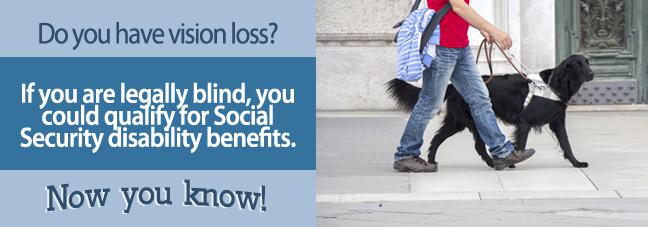Over 3% of Americans over the age of 40 are either legally blind or are visually impaired. Severe visual impairments can be frustrating and painful, making it difficult to complete daily tasks or live your normal life. It can be even more frustrating when your initial disability application is denied, preventing you from receiving the benefits that can help you.
However, surprisingly enough, around 65% of initial disability applications are denied. If you are a part of this 65%, you are far from alone. Continue below to learn what may have caused your vision loss application to be denied, and what you can do to ensure you get approved at your next hearing.
Potential Causes for Vision Loss Denial
Vision loss can be a result of a variety of diseases such as cataracts, macular degeneration, or glaucoma. The Social Security Administration (SSA) evaluates all of these vision disorders not by name, but by the vision problems they cause. This means that, in most cases, a mere diagnosis is not enough to qualify a person for vision loss disability benefits. Some other reasons for denial may include:
- Lack of SSA-recognized tests. Vision loss can be assessed by dozens of different tests. Social Security reviewers accept only specific tests in order to officially evaluate your eyesight. This includes visual acuity testing via Snellen methodology, automated refraction acuity testing, cyclopedic refraction testing, visual field testing, and other perimetry tests. Consult with your physician to be sure your eye tests are Blue Book-approved.
- Vision ratings that do not meet Blue Book requirements. For each of the Blue Book’s three sections on vision loss, a different vision rating is required. For example, benefits can be provided to those with a Central Visual Acuity (CVA) rating of 20/200 or less, or to those with a visual efficiency percentage of 20 or less after best correction. Those who do not meet these numbers, while having vision troubles, may not qualify as “totally and permanently disabled” by Blue Book standards.

Preparing for Your Disability Hearing
Disability hearings are the next step for any applicant whose initial case was denied. Hearings can be scheduled at your local Office of Disability Adjudication and Review (ODAR), which is typically located within your closest big city. ALJ Hearings should be scheduled as soon as you decide to continue with the process. This is because wait times typically delay hearings for a period of months, during which you can prepare the paperwork you need.
Items you may want to prepare for your hearing include:
- original paperwork submitted for your initial application
- updated vision tests (the more the better)
- medication lists and hospitalization records
- therapy and diet regimens (if applicable)
- testimonies from physicians, therapists, old bosses, old coworkers, or loved ones that can attest to your condition
Speaking with a Disability Attorney
While it may seem drastic, contacting a disability attorney is much easier than you think. Disability attorneys exist for situations exactly like yours, where their legal experience can help smooth out the process and increase your chances of getting benefits. In addition, federal regulation prevents disability attorneys from being paid unless their services help you to win your case, reducing the risk of hiring.
Before your hearing, consider speaking with a disability attorney to see if their services may be right for you.